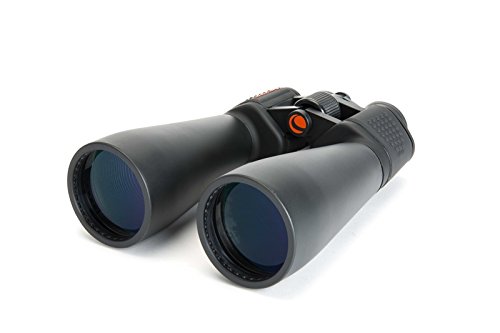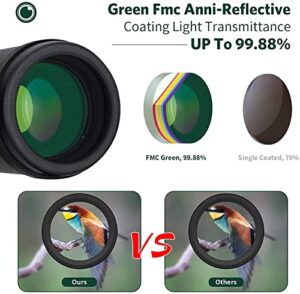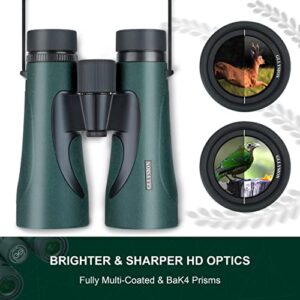Celestron and ;s SkyMaster Series of large aperture binoculars are a phenomenal value for high performance binoculars ideal for astronomical viewing or for terrestrial (land) use – especially over long distances. Each SkyMaster model features high quality BAK-4 prisms and multi-coated optics for enhanced contrast. Celestron has designed and engineered the larger SkyMaster models to meet the special demands of extended astronomical or terrestrial viewing sessions. The 15×70 version is one of the most popular models in the series. It offers serious large aperture light gathering in an affordable and reasonably lightweight configuration. Binoculars come in a wide range of shapes and sizes these days, and an even wider range of prices. It’s easy to spend less than $100 or more than $500 for what may appear to be, at least outwardly, comparable models. While they may look the same, they are probably quite different on the inside.
Recently, the binocular market has seen a flood of giant binoculars at prices that were unheard of just a few years ago. In general, giant binoculars are defined as those that magnify the view 10 times or more and have 70-mm or larger front (objective) lenses. It used to be that the least expensive giant binoculars cost in excess of $150, even $200. All that changed not long ago, when the bottom fell out of the price cellar. Now, several companies import giant binoculars that sell for half that, or less.
Celestron’s 15×70 SkyMaster binoculars are one of the leaders in the low-price giant binocular arena. They certainly sound good on paper. The SkyMasters include multicoated optics and BaK-4 internal prisms, two features that promise brighter, better images, and key points to look for when judging a pair of binoculars. They also come with an adapter for attaching them to a photo tripod, which is a must to use them to their fullest, and a soft carrying case. But just because they are cheap doesn’t always mean they are worth the price. Would it be better to save up for a more expensive pair?
To find the answer, I had an opportunity recently to judge the SkyMasters against a pair of Fujinon 16×70 FMT-SX binoculars , one of the finest pairs of giant binoculars sold today. Like the SkyMasters, the Fujinons feature BaK-4 prisms, but also have fully multicoated optics. As a general rule, superior coatings mean superior image sharpness and contrast. But then, that should be expected, given that the Fujinons cost many times more than the Celestrons.
While the Fujinons were clearly the better performer, the Celestron SkyMasters held up admirably. Image brightness, quality, and contrast were all remarkable considering their bargain price. Although images were a little soft across the outer 25% of the Celestron’s field, the overall view was impressive nonetheless.
Some inexpensive binoculars have very sloppy focusing, causing the eyepieces to tilt and shift. Not so with the SkyMasters. I found that their center-focusing mechanism worked smoothly, with no apparently backlash or wobble. Eye relief (the distance you hold your eyes away from the eyepieces to see the full field) is stated to be 18 mm, a good distance for higher power binoculars and an important consideration if you must wear glasses when viewing. The SkyMasters are also light enough to support by hand for short periods of time, although buyers would be well advised to mount them on a sturdy photo tripod.
The bottom line is, if you are considering a pair of giant binoculars, whether for bird watching, stargazing, or another recreational use, and have a limited budget, Celestron’s giant 15×70 SkyMasters represent an excellent value. –Phil Harrington, author of Star Ware and Star Watch
Pros: Exceptional value for the price Light enough to support by hand BaK-4 prisms Multicoated optics Cons: Outer 25% of the field is soft and a little blurry Requires a tripod to use for extended periods
Product Features
- Multi-coated optics
- Large aperture perfect for low light conditions and stargazing
- Tripod adapter
- 13 mm (0.51 in) long eye relief ideal for eyeglass wearers
- Diopter adjustment for fine focusing





Celestron 15X70 Skymasters ROCK! I’ve been an amateur astronomer for about 23 years. I have a broad amount of experience with the kind of optics that are used for astronomy. I have used most every type of instrument and have visited some of the great professional telescopes. I have hand built my own newtonian telescope including machining the german equatorial mount. Soon after completing this instrument I took it to a star party and ended up on my back with a pair of Fujinon SX binoculars. To make a long story short, I…
More than I hoped for My first night out under dark skies with these binoculars was a terrific experience. In ninety minutes of observing I had great views of M36, M37, M38, M44, M50, easily saw the Trapizium in Orion’s nebula, saw the Andromeda galaxy and it’s companions streaching across 75% of my FOV. It had taken me two observing sessions with my 5″ reflector to find M33, with the Binoculars I found it in two minutes, M81 and 82 were also easy.
A quantum leap above my 10×50’s for viewing deep sky objects I purchased the 15×70 Celestron Skymaster Binoculars primarily for casual astronomical viewing. Most of my remarks and observations center around using them for deep sky scans.